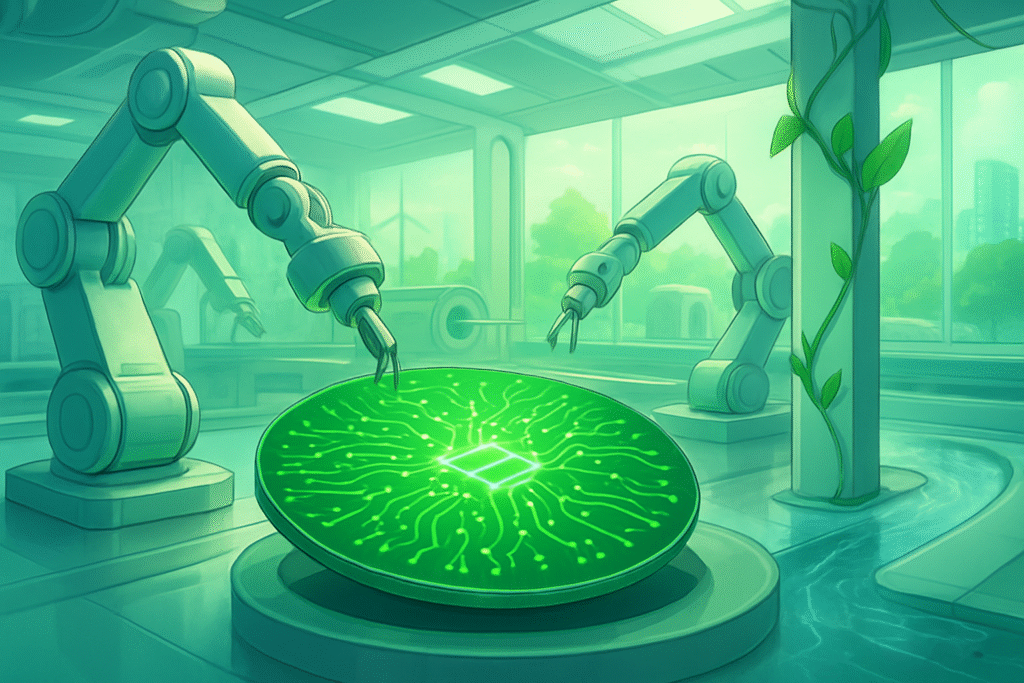
The rapid advancement of Artificial Intelligence is ushering in an era of unprecedented technological innovation, but this progress comes with a significant environmental and ethical cost, particularly within the semiconductor industry. As AI's demand for computing power escalates, the necessity for sustainable semiconductor manufacturing practices, focusing on "green AI chips," has become paramount. This global imperative aims to drastically reduce the environmental impact of chip production and promote ethical practices across the entire supply chain, ensuring that the technological progress driven by AI does not come at an unsustainable ecological cost.
The semiconductor industry, the bedrock of modern technology, is notoriously resource-intensive, consuming vast amounts of energy, water, and chemicals, leading to substantial greenhouse gas (GHG) emissions and waste generation. The increasing complexity and sheer volume of chips required for AI applications amplify these concerns. For instance, AI accelerators are projected to cause a staggering 300% increase in CO2 emissions between 2025 and 2029. U.S. data centers alone have tripled their CO2 emissions since 2018, now accounting for over 2% of the country's total carbon emissions from energy usage. This escalating environmental footprint, coupled with growing regulatory pressures and stakeholder expectations for Environmental, Social, and Governance (ESG) standards, is compelling the industry towards a "green revolution" in silicon.
Technical Advancements Driving Green AI Chips
The drive for "green AI chips" is rooted in several key technical advancements and initiatives aimed at minimizing environmental impact throughout the semiconductor lifecycle. This includes innovations in chip design, manufacturing processes, material usage, and facility operations, moving beyond traditional approaches that often prioritized output and performance over ecological impact.
A core focus is on energy-efficient chip design and architectures. Companies like ARM are developing energy-efficient chip architectures, while specialized AI accelerators offer significant energy savings. Neuromorphic computing, which mimics the human brain's architecture, provides inherently energy-efficient, low-latency solutions. Intel's (NASDAQ: INTC) Hala Point system, BrainChip's Akida Pulsar, and Innatera's Spiking Neural Processor (SNP) are notable examples, with Akida Pulsar boasting up to 500 times lower energy consumption for real-time processing. In-Memory Computing (IMC) and Processing-in-Memory (PIM) designs reduce data movement, significantly slashing power consumption. Furthermore, advanced materials like silicon carbide (SiC) and gallium nitride (GaN) are enabling more energy-efficient power electronics. Vertical Semiconductor, an MIT spinoff, is developing Vertical Gallium Nitride (GaN) AI chips that aim to improve data center efficiency by up to 30%. Advanced packaging techniques such as 2.5D and 3D stacking (e.g., CoWoS, 3DIC) also minimize data travel distances, reducing power consumption in high-performance AI systems.
Beyond chip design, sustainable manufacturing processes are undergoing a significant overhaul. Leading fabrication plants ("fabs") are rapidly integrating renewable energy sources. Taiwan Semiconductor Manufacturing Company (TSMC) (NYSE: TSM, TWSE: 2330) has signed massive renewable energy power purchase agreements, and GlobalFoundries (NASDAQ: GFS) aims for 100% carbon-neutral power by 2050. Intel has committed to net-zero GHG emissions by 2040 and 100% renewable electricity by 2030. The industry is also adopting advanced water reclamation systems, with GlobalFoundries achieving a 98% recycling rate for process water. There's a strong emphasis on eco-friendly material usage and green chemistry, with research focusing on replacing harmful chemicals with safer alternatives. Crucially, AI and machine learning are being deployed to optimize manufacturing processes, control resource usage, predict maintenance needs, and pinpoint optimal chemical and energy usage in real-time. The U.S. Department of Commerce, through the CHIPS and Science Act, launched a $100 million competition to fund university-led projects leveraging AI for sustainable semiconductor materials and processes.
This new "green AI chip" approach represents a paradigm shift towards "sustainable-performance," integrating sustainability across every stage of the AI lifecycle. Unlike past industrial revolutions that often ignored environmental consequences, the current shift aims for integrated sustainability at every stage. Initial reactions from the AI research community and industry experts underscore the urgency and necessity of this transition. While challenges like high initial investment costs exist, they are largely viewed as opportunities for innovation and industry leadership. There's a widespread recognition that AI itself plays a "recursive role" in optimizing chip designs and manufacturing processes, creating a virtuous cycle of efficiency, though concerns remain about the rapid growth of AI potentially increasing electricity consumption and e-waste if not managed sustainably.
Business Impact: Reshaping Competition and Market Positioning
The convergence of sustainable semiconductor manufacturing and green AI chips is profoundly reshaping the business landscape for AI companies, tech giants, and startups. This shift, driven by escalating environmental concerns, regulatory pressures, and investor demands, is transforming how chips are designed, produced, and utilized, leading to significant competitive implications and strategic opportunities.
Several publicly traded companies are poised to gain substantial advantages. Semiconductor manufacturers like Intel (NASDAQ: INTC), TSMC (NYSE: TSM, TWSE: 2330), and Samsung (KRX: 005930, OTCMKTS: SSNLF) are making significant investments in sustainable practices, ranging from renewable energy integration to AI-driven manufacturing optimization. NVIDIA (NASDAQ: NVDA), a dominant force in AI GPUs, is committed to reducing its environmental impact through energy-efficient data center technologies and responsible sourcing, with its Blackwell GPUs designed for superior performance per watt. Electronic Design Automation (EDA) companies such as Synopsys (NASDAQ: SNPS) and Cadence (NASDAQ: CDNS) are expanding their suites with generative AI capabilities to accelerate the development of more efficient chips. Equipment suppliers like ASML Holding N.V. (NASDAQ: ASML, Euronext Amsterdam: ASML) also play a critical role, with their lithography innovations enabling smaller, more energy-efficient chips.
Tech giants providing cloud and AI services, including Google (NASDAQ: GOOGL), Amazon (NASDAQ: AMZN), and Microsoft (NASDAQ: MSFT), are heavily investing in custom silicon tailored for AI inference to reduce reliance on third-party solutions and gain more control over their environmental footprint. Google's Ironwood TPU, for example, is nearly 30 times more power-efficient than its first Cloud TPU. These companies are also committed to carbon-neutral data centers and investing in clean technology. IBM (NYSE: IBM) aims for net-zero greenhouse gas emissions by 2030. Startups like Vertical Semiconductor, Positron, and Groq are emerging, focusing on optimizing inference for better performance per watt, challenging established players by prioritizing energy efficiency and specialized AI tasks.
The shift towards green AI chips is fundamentally altering competitive dynamics, making "performance per watt" a critical metric. Companies that embrace and drive eco-friendly practices gain significant advantages, while those slow to adapt face increasing regulatory and market pressures. This strategic imperative is leading to increased in-house chip development among tech giants, allowing them to optimize chips not just for performance but also for energy efficiency. The drive for sustainability will disrupt existing products and services, accelerating the obsolescence of less energy-efficient designs and spurring innovation in green chemistry and circular economy principles. Companies prioritizing green AI chips will gain significant market positioning and strategic advantages through cost savings, enhanced ESG credentials, new market opportunities, and a "sustainable-performance" paradigm where environmental responsibility is integral to technological advancement.
Wider Significance: A Foundational Shift for AI and Society
The drive towards sustainable semiconductor manufacturing and the development of green AI chips represents a critical shift with profound implications for the broader artificial intelligence landscape, environmental health, and societal well-being. This movement is a direct response to the escalating environmental footprint of the tech industry, particularly fueled by the "AI Supercycle" and the insatiable demand for computational power.
The current AI landscape is characterized by an unprecedented demand for semiconductors, especially power-hungry GPUs and Application-Specific Integrated Circuits (ASICs), necessary for training and deploying large-scale AI models. This demand, if unchecked, could lead to an unsustainable environmental burden. Green AI, also referred to as Sustainable AI or Net Zero AI, integrates sustainability into every stage of the AI lifecycle, focusing on energy-efficient hardware, optimized algorithms, and renewable energy for data centers. This approach is not just about reducing the factory's environmental impact but about enabling a sustainable AI ecosystem where complex models can operate with a minimal carbon footprint, signifying a maturation of the AI industry.
The environmental impacts of the semiconductor industry are substantial, encompassing vast energy consumption (projected to consume nearly 20% of global energy production by 2030), immense water usage (789 million cubic meters globally in 2021), the use of hazardous chemicals, and a growing problem of electronic waste (e-waste), with data center upgrades for AI potentially adding an extra 2.5 million metric tons annually by 2030. Societal impacts of sustainable manufacturing include enhanced geopolitical stability, supply chain resilience, and improved ethical labor practices. Economically, it drives innovation, creates new market opportunities, and can lead to cost savings.
However, potential concerns remain. The initial cost of adopting sustainable practices can be significant, and ecosystem inertia poses adoption challenges. There's also the "paradox of sustainability" or "rebound effect," where efficiency gains are sometimes outpaced by rapidly growing demand, leading to an overall increase in environmental impact. Regulatory disparities across regions and challenges in accurately measuring AI's true environmental impact also need addressing. This current focus on semiconductor sustainability marks a significant departure from earlier AI milestones, where environmental considerations were often secondary. Today, the "AI Supercycle" has brought environmental costs to the forefront, making green manufacturing a direct and urgent response.
The long-term impact is a foundational infrastructural shift for the tech industry. We are likely to see a more resilient, resource-efficient, and ethically sound AI ecosystem, including inherently energy-efficient AI architectures like neuromorphic computing, a greater push towards decentralized and edge AI, and innovations in advanced materials and green chemistry. This shift will intrinsically link environmental responsibility with innovation, contributing to global net-zero goals and a more sustainable future, addressing concerns about climate change and resource depletion.
Future Developments: A Roadmap to a Sustainable Silicon Era
The future of green AI chips and sustainable manufacturing is characterized by a dual focus: drastically reducing the environmental footprint of chip production and enhancing the energy efficiency of AI hardware itself. This shift is not merely an environmental imperative but also an economic one, promising cost savings and enhanced brand reputation.
In the near-term (1-5 years), the industry will intensify efforts to reduce greenhouse gas emissions through advanced gas abatement techniques and the adoption of less harmful gases. Renewable energy integration will accelerate, with more fabs committing to ambitious carbon-neutral targets and signing Power Purchase Agreements (PPAs). Stricter regulations and widespread deployment of advanced water recycling and treatment systems are anticipated. There will be a stronger emphasis on sourcing sustainable materials and implementing green chemistry, exploring environmentally friendly materials and biodegradable alternatives. Energy-efficient chip design will continue to be a priority, driven by AI and machine learning optimization. Crucially, AI and ML will be deeply embedded in manufacturing for continuous optimization, enabling precise control over processes and predicting maintenance needs.
Long-term developments (beyond 5 years) envision a complete transition towards a circular economy for AI hardware, emphasizing recycling, reusing, and repurposing of materials. Further development and widespread adoption of advanced abatement systems, potentially incorporating technologies like direct air capture (DAC), will become commonplace. Given the immense power demands, nuclear energy is emerging as a long-term, environmentally friendly solution, with major tech companies already investing in this space. A significant shift towards inherently energy-efficient AI architectures such as neuromorphic computing, in-memory computing (IMC), and optical computing is crucial. A greater push towards decentralized and edge AI will reduce the computational load on centralized data centers. AI-driven autonomous experimentation will accelerate the development of new semiconductor materials, optimizing resource usage.
These green AI chips and sustainable manufacturing practices will enable a wide array of applications across cloud computing, 5G, advanced AI, consumer electronics, automotive, healthcare, industrial automation, and the energy sector. They are critical for powering hyper-efficient cloud and 5G networks, extending battery life in devices, and driving innovation in autonomous vehicles and smart factories.
Despite significant progress, several challenges must be overcome. The high energy consumption of both fabrication plants and AI model training remains a major hurdle, with energy usage projected to grow by 12% CAGR from 2025-2035. The industry's reliance on vast amounts of hazardous chemicals and gases, along with immense water requirements, continues to pose environmental risks. E-waste, supply chain complexity, and the high cost of green manufacturing are also significant concerns. The "rebound effect," where efficiency gains are offset by increasing demand, means carbon emissions from semiconductor manufacturing are predicted to grow by 8.3% through 2030, reaching 277 million metric tons of CO2e.
Experts predict a dynamic evolution. Carbon emissions from semiconductor manufacturing are projected to continue growing in the short term, but intensified net-zero commitments from major companies are expected. AI will play a dual role—driving demand but also instrumental in identifying sustainability gaps. The focus on "performance per watt" will remain paramount in AI chip design, leading to a surge in the commercialization of specialized AI architectures like neuromorphic computing. Government and industry collaboration, exemplified by initiatives like the U.S. CHIPS for America program, will foster sustainable innovation. However, experts caution that hardware improvements alone may not offset the rising demands of generative AI systems, suggesting that energy generation itself could become the most significant constraint on future AI expansion. The complex global supply chain also presents a formidable challenge in managing Scope 3 emissions, requiring companies to implement green procurement policies across their entire supply chain.
Comprehensive Wrap-up: A Pivotal Moment for AI
The relentless pursuit of artificial intelligence has ignited an unprecedented demand for computational power, simultaneously casting a spotlight on the substantial environmental footprint of the semiconductor industry. As AI models grow in complexity and data centers proliferate, the imperative to produce these vital components in an eco-conscious manner has become a defining challenge and a strategic priority for the entire tech ecosystem. This paradigm shift, often dubbed the "Green IC Industry," signifies a transformative journey towards sustainable semiconductor manufacturing and the development of "green AI chips," redefining how these crucial technologies are made and their ultimate impact on our planet.
Key takeaways from this green revolution in silicon underscore a holistic approach to sustainability. This includes a decisive shift towards renewable energy dominance in fabrication plants, groundbreaking advancements in water conservation and recycling, the widespread adoption of green chemistry and eco-friendly materials, and the relentless pursuit of energy-efficient chip designs and manufacturing processes. Crucially, AI itself is emerging as both a significant driver of increased energy demand and an indispensable tool for achieving sustainability goals within the fab, optimizing operations, managing resources, and accelerating material discovery.
The overall significance of this escalating focus on sustainability is profound. It's not merely an operational adjustment but a strategic force reshaping the competitive landscape for AI companies, tech giants, and innovative startups. By mitigating the industry's massive environmental impact—from energy and water consumption to chemical waste and GHG emissions—green AI chips are critical for enabling a truly sustainable AI ecosystem. This approach is becoming a powerful competitive differentiator, influencing supply chain decisions, enhancing brand reputation, and meeting growing regulatory and consumer demands for responsible technology.
The long-term impact of green AI chips and sustainable semiconductor manufacturing extends across various facets of technology and society. It will drive innovation in advanced electronics, power hyper-efficient AI systems, and usher in a true circular economy for hardware, emphasizing resource recovery and waste reduction. This shift can enhance geopolitical stability and supply chain resilience, contributing to global net-zero goals and a more sustainable future. While initial investments can be substantial, addressing manufacturing process sustainability directly supports business fundamentals, leading to increased efficiency and cost-effectiveness.
As the green revolution in silicon unfolds, several key areas warrant close attention in the coming weeks and months. Expect accelerated renewable energy adoption, further sophistication in water management, and continued innovation in green chemistry and materials. The integration of AI and machine learning will become even more pervasive in optimizing every facet of chip production. Advanced packaging technologies like 3D integration and chiplets will become standard. International collaboration and policy will play a critical role in establishing global standards and ensuring equitable access to green technologies. However, the industry must also address the "energy production bottleneck," as the ever-growing demands of newer AI models may still outpace improvements in hardware efficiency, potentially making energy generation the most significant constraint on future AI expansion. The complex global supply chain also presents a formidable challenge in managing Scope 3 emissions, requiring companies to implement green procurement policies across their entire supply chain.
In conclusion, the journey towards "green chips" represents a pivotal moment in the history of technology. What was once a secondary consideration has now become a core strategic imperative, driving innovation and reshaping the entire tech ecosystem. The ability of the industry to overcome these hurdles will ultimately determine the sustainability of our increasingly AI-powered world, promising not only a healthier planet but also more efficient, resilient, and economically viable AI technologies.
This content is intended for informational purposes only and represents analysis of current AI developments.
TokenRing AI delivers enterprise-grade solutions for multi-agent AI workflow orchestration, AI-powered development tools, and seamless remote collaboration platforms.
For more information, visit https://www.tokenring.ai/.






